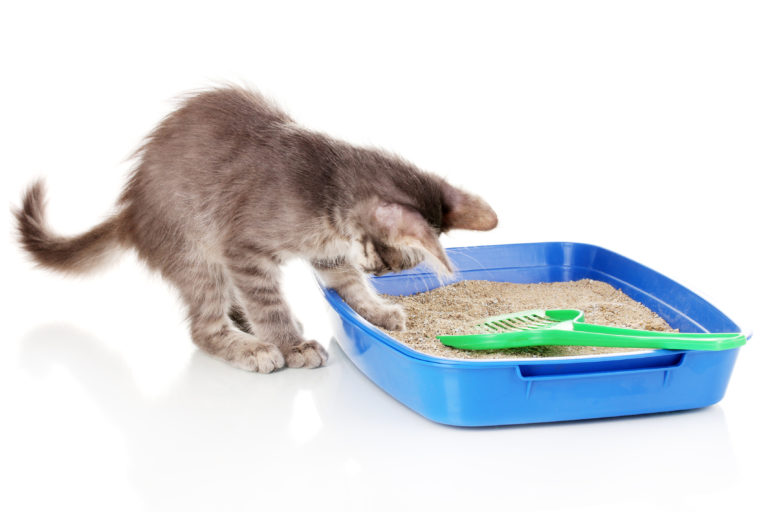Cat toilets are always the same – or is this not the case? If you’re on the lookout for the right “quiet spot” for your cat, you can choose between two varieties aside from different sizes and colours: litter boxes or trays without a hood. What advantages and disadvantages do these two alternatives have?
Litter Box vs Litter Tray for Cats

© Africa Studio / stock.adobe.com
Small grey kitten in blue plastic litter cat isolated on white
Table of contents
Space requirements
Cat toilets with a hood are much taller than litter trays. Litter boxes can be around 50cm in height, whilst open litter trays are 20 to 30cm high. Of course this doesn’t change anything regarding the space a cat needs in order to do its business. However, it does make litter trays a bit more flexible when it comes to finding the right spot for the cat toilet.
Nevertheless, the size of the cat toilet should be adapted to the size of your cat. A larger cat needs more space to turn around, squat and scratch than a small cat. This is particularly applicable to using a litter box, since here the cat doesn’t have the opportunity to point its tail or whiskers outside of the toilet! Keep this in mind and purchase a litter box that offers your cat sufficient space.
Appearance
However much you love your cat, used cat litter isn’t a pretty sight. Litter boxes are more discreet than trays, because they always hide your cat when it does its business. This can be a big advantage particularly when cat toilets are in the human’s field of vision! In contrast, the lack of a hood soon makes it obvious when your cat has used a litter tray. Anyhow, this can provide motivation to clean it quickly!
Smell
Cats are clean animals, but can often leave a bad smell behind after going to the toilet… A litter box conceals the bad smells under the hood and seals them off to ensure that they can’t spread freely around the living environment. This is pleasant for humans, but not necessarily for cats too…
Incidentally, the hygiene of a cat toilet depends particularly on the litter used and regular cleaning. Commercially available products make it easier to regularly clean and disinfect the cat toilet.
Cat behaviour
Doing one’s business in secret: although it is self-evident for us humans to protect our pets’ privacy, cats see the world from a different perspective. Cats want to be hunters, though they also have natural enemies outdoors. When going to the cat toilet, cats wish to feel safe and able to escape at any time. A litter box makes it easier for them to look around for potential enemies and means of escape. In contrast, there is only one way in and one way out of a litter box, and the means of escape can easily be blocked by possible enemies or fellow cats. Not just anxious cats can feel unsafe or trapped in a litter box. From a feline perspective, a litter tray is definitely preferable to a box!
Regardless of what type of cat toilet you choose, it is essential to regularly clean out the cat litter, at least once or twice per day. Our selection of cat litter products in the zooplus magazine can help you choose the right litter. In houses with more than one cat, you should ideally provide several cat toilets to avoid territorial behaviour and conflicts. The ideal number of cat toilets should be the number of cats in the home and one extra – however, even cats that are friendly to one another often have problems sharing a toilet.
All the best for you and your cat!
Cat litter: Clumping or Silica Litter?
Cats during puberty: When cats become adults
Sharing a Home: Cats and Birds
46% of UK households own a pet, with a total pet population of 58 million, including 7 million cats and 0.5 million indoor birds. Many pet owners provide a home for more than one type of pet, with cats sometimes sharing a home with a budgie, parakeet or other bird, but what happens when you have a cat and a small pet?